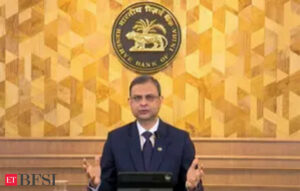Despite maintaining a stable outlook for India at Baa3 and P-3, rating agency Moody’s has said that escalation of political tensions or further weakening of checks and balances that would undermine India’s long-term growth potential would likely put downward pressure on the rating.
“Baa susceptibility to event risk, driven by political risk to account for rising sectarian tensions and intensifying domestic political polarization,” said Moody’s Analytics in its recent outlook.
Moody’s on the positive end noted that India’s economy has high growth potential, a relatively sound external position and low per capita income.
“India’s fiscal metrics will continue to gradually improve amid robust growth prospects compared with peers. Upside risks to inflation and correspondingly higher interest rates could challenge efforts to rein in spending and exacerbate already weak debt affordability,” said Moody’s.
The rating agency also believes that the economic and social benefits of digitalisation could be higher than what is being predicted now. “Benefiting from traction on infrastructure development, digitalization and the rehabilitation of the financial system, a stronger and more stable economy has emerged from the pandemic, although we do not expect a material reduction in debt amid gradual fiscal consolidation over the next year,” noted Moody’s.
Ahead of the upcoming 18th Lok Sabha polls, the rating agency expects a rise in private investment. “Private investment could rise as election-related uncertainties clear and policy rates start to fall as inflation normalizes within the Reserve Bank of India’s target band,” said Moody’s.
India’s debt burden
Commenting on the Narendra Modi-led government’s efforts to ease debt burden, Moody’s expects India’s debt affordability ratio to remain weak as compared to Baa-rated emerging market peers, driven by the country’s relatively high debt burden and historically higher interest rate cost structure.
However, the agency does expect some stability with help of largely domestic captive source of financing. “Despite the buoyancy of revenue supported by reforms such as the implementation of the goods and services tax (GST) and digitalization, debt affordability has been worsening over the past decade although it has eased somewhat since the peak of the pandemic,” commented Moody’s.
Upward pressure on the rating would develop if progress on India’s fiscal consolidation would lead to a material decline in the government’s debt burden and an improvement in debt affordability that materially and durably enhances fiscal strength.
Apart from political tensions, the agency has claimed that an ongoing rise in the debt burden would weaken the sovereign’s fiscal strength and put downward pressure on the rating.
Recently, Moody’s revised India’s real GDP growth projection to 8% for the full fiscal year, as contributions from gross fixed capital formation remain robust, amid the authorities’ ongoing emphasis on infrastructure development.










